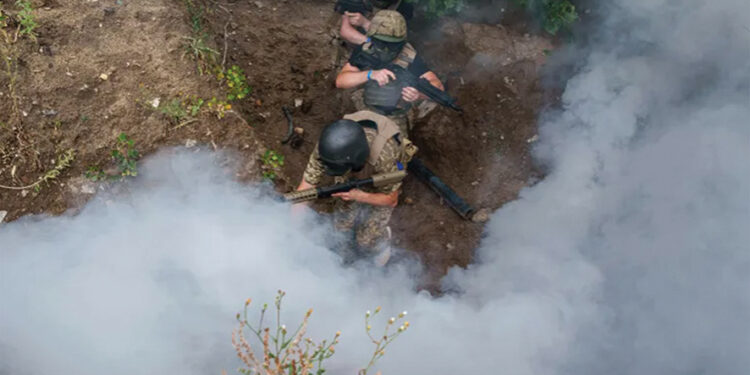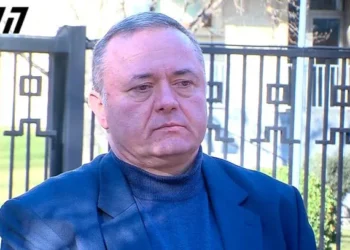As the war in Ukraine grinds through its third brutal summer, the past week brought a flurry of intense aerial assaults, rising civilian casualties, and strategic diplomatic movements across Europe and the US.
Here’s where things stand:
Eastern Ukraine continues to suffer from devastating Russian air raids. On Wednesday, a Russian bomb struck a bustling shopping center and open-air market in Dobropillia, in the Donetsk region. Regional governor Vadym Filashkin says the attack involved a 500-kilogram bomb. At least two people were killed and 22 others injured, with severe damage reported across the area.
Simultaneously, Russia launched a massive overnight drone offensive. Ukrainian Air Force says over 400 Iranian-made Shahed drones and decoy drones were deployed along with a ballistic missile. These targeted cities across Ukraine—including Kharkiv in the northeast, Kryvyi Rih in central Ukraine, Vinnytsia in the west, and the southern port city of Odesa. Ukrainian air defenses reportedly intercepted a significant portion of the attacks, but not without material damage and civilian anxiety.
The Ukrainian counter-offensive in Russian-held territories and border regions also continued this week. A Ukrainian drone strike on the Russian city of Belgorod killed one person and injured six, while another strike on a nearby village injured one more civilian. In Russia’s Smolensk region, a separate drone attack injured one individual, says local governor Vasily Anokhin.
Early Thursday morning, Moscow itself came under threat once again as three Ukrainian drones were intercepted over the capital. Mayor Sergei Sobyanin confirmed the attack via Telegram, stating that no casualties or structural damage were reported. Russia’s Ministry of Defense claimed that its air defense systems destroyed 48 Ukrainian drones within just three and a half hours late Wednesday, marking one of the busiest nights in months for drone warfare.
Ukrainian President Volodymyr Zelensky outlined a bold plan for military self-sufficiency in his nightly address on Wednesday. Emphasizing the urgency of securing a more sustainable supply of weapons, Zelensky declared that Ukraine aims to produce at least 50% of its required weaponry domestically within the next six months. “The production volumes are truly large, but we need more,” he said, acknowledging the limitations of relying solely on foreign aid.
Meanwhile, Bahrain confirmed it will not transfer any US-purchased Patriot air defense systems to Ukraine. The announcement came during a joint press conference at the White House, where Bahrain’s Crown Prince Salman bin Hamad Al Khalifa clarified his country’s position in response to speculation about re-exports of US-made systems.
As the fighting continues, diplomatic activity around the war has intensified. German Chancellor Friedrich Merz met with newly elected UK Prime Minister Keir Starmer on Thursday in London. Their discussions focused heavily on coordinating military and humanitarian support for Ukraine. The two nations signed a comprehensive friendship treaty, which includes a mutual assistance clause viewed as a “highly significant” step amid growing Russian aggression.
In a significant financial move, the European Commission proposed a 100-billion-euro fund aimed at supporting Ukraine’s long-term recovery and reconstruction. EU Budget Commissioner Piotr Serafin described the fund as a “long-term commitment” not only to Ukraine’s physical recovery, but to the stabilization of its democratic institutions and economic sustainability.
With the NATO summit just weeks away, alliance leaders are preparing to unveil a new strategy for Ukraine. Reports suggest a potential shift toward multi-year defense planning and expanded training programs for Ukrainian troops, as well as joint production ventures to scale up Europe-based weapons manufacturing. These measures are expected to supplement Kyiv’s own domestic military production efforts.
Meanwhile, Finland, Poland, and the Baltic states have called for the deployment of additional NATO forces along the eastern flank, citing increased Russian military activity in Belarus and Kaliningrad. Intelligence sources also suggest Russia is moving additional Iskander missile systems closer to the Polish border, a move that NATO has described as “provocative.”
The humanitarian toll continues to mount. With fresh attacks hitting civilian infrastructure almost daily, millions remain displaced or without access to consistent electricity and water. International aid groups report a rise in mental health concerns among children in eastern Ukraine and are calling for expanded funding and logistical support to deliver relief in hard-to-reach areas.
As of mid-July 2025, the war shows no signs of abating. Drone warfare and long-range attacks have become a defining feature of this phase, with both sides pushing technological and strategic boundaries. While Ukraine continues to rally international support and build domestic capacity, Russia’s relentless air raids and missile strikes underscore the difficulty of reaching a decisive military resolution.
Diplomatic talks may gain momentum in the second half of the year, especially following the NATO summit and further EU-US cooperation.
Compiled by Ana Dubadze














